- Electronics
- Accessories
The Best Power Banks for Laptops With USB-C

By Sarah Witman
Sarah Witman is a writer focused on batteries and charging accessories. She has spent countless hours charging, discharging, and recharging batteries.
Working is hard, and when your laptop is close to dying, it’s even harder. Fortunately, a high-capacity power bank can save the day when you’re low on battery and outlets are out of reach—or if you need to charge your phone and other small devices during a power outage.
The Anker 747 PowerCore 26K is the best power bank for laptops that charge via USB-C because it fully recharges most laptops at least once and does so as quickly as possible, yet it’s compact enough to carry in a backpack, a laptop bag, or even some purses.
Everything we recommend
Top pick
Anker 747 PowerCore 26K
The best USB power bank for most laptops
This power bank has two USB-C PD ports, two USB-A ports, and enough capacity to charge most laptops at least once. It lacks pass-through charging, but includes a wall charger.
Buying Options
You save $59 (41%)
You save $59 (41%)
Also great
Omnicharge Omni Mobile 25600
If you want lots of charging options
With a USB-C PD port, a DC port, two USB-A ports, and a wireless charging pad, this power bank has oodles of charging options. It doesn’t come with a wall charger, but it’s compact and has enough capacity to charge most laptops at least once.
Buying Options
Use promo codePOWERBANK20
Budget pick
Einova Eggtronic 63W Power Bank
More portable, less power
This power bank has one USB-C PD port, two USB-A ports, and a sleek fabric exterior. It has less capacity and power than other options, but it’s also the lightest and cheapest model we recommend.
Buying Options
Testing notes
-
USB-C PD charging
We required every power bank in our test group to have at least one fast-charging USB-C Power Delivery (PD) port.
-
At least 30 watts
We required each model to support an output of 30 watts (W) or higher, as most laptops need at least that much power to charge.
-
Up to 100 watt-hours
We disqualified models with a capacity rating over 100 watt-hours (Wh) since most airlines don’t allow them in a carry-on bag.
-
Less than 2 pounds
As these power banks are often carried around in a backpack or a laptop bag, we disqualified models weighing 2 pounds or more.
How we picked and tested
Top pick
Anker 747 PowerCore 26K
The best USB power bank for most laptops
This power bank has two USB-C PD ports, two USB-A ports, and enough capacity to charge most laptops at least once. It lacks pass-through charging, but includes a wall charger.
Buying Options
You save $59 (41%)
You save $59 (41%)
The Anker 747 PowerCore 26K has two USB-C Power Delivery (PD) ports that deliver up to 87 W apiece, or 63 W combined, and two USB-A ports that can charge at up to 15 W (the total maximum output of all four ports is 78 W). With a rated capacity of 25,600 mAh, or roughly 92 Wh, it can fully charge most laptops at least once (or charge smaller devices several times over) while still meeting carry-on luggage requirements.
It’s ruggedly built yet sleek-looking, small, and light at just 1.3 pounds. It couldn’t be simpler to use, either: A single button turns it on and off, and a ring of small lights signals when it’s charging and roughly how much battery life remains.
Anker backs this power bank with an 18-month warranty and includes a high-quality 65 W charger and USB-C cable in the box.
Its biggest downside is that it doesn’t allow pass-through charging—so you can’t charge other devices while the power bank itself is charging—but if you can live with that unfortunate omission, it’s a great choice.
Advertisement
SKIP ADVERTISEMENT
Also great
Omnicharge Omni Mobile 25600
If you want lots of charging options
With a USB-C PD port, a DC port, two USB-A ports, and a wireless charging pad, this power bank has oodles of charging options. It doesn’t come with a wall charger, but it’s compact and has enough capacity to charge most laptops at least once.
Buying Options
Use promo codePOWERBANK20
If you want a portable laptop charger with a round DC port or a wireless charging pad, opt for the Omnicharge Omni Mobile 25600.
Its rated capacity of 25,600 mAh is equal to that of our top pick, giving it enough juice to bring most laptop batteries from empty to full at least once.
And although its output capabilities fall a bit short of what you get from our top pick, this charger’s 60 W USB-C PD port, two 18 W USB-A ports, 72 W DC port, and 10 W wireless charging pad, allow you to charge the widest variety of devices when you’re on the go.
A hair lighter than our top pick, this charger weighs just 1.2 pounds, has a professional look, is easy to use, and is equipped with pass-through charging capabilities. It comes with two charging cables (one C-to-C cable and one A-to-C cable), but unlike with our top pick you’ll have to supply your own wall charger.
Its one-year warranty is shorter than that of our top pick but should still give you plenty of time to make sure you don’t have a dud.
Budget pick
Einova Eggtronic 63W Power Bank
More portable, less power
This power bank has one USB-C PD port, two USB-A ports, and a sleek fabric exterior. It has less capacity and power than other options, but it’s also the lightest and cheapest model we recommend.
Buying Options
If money is tight, but you still want to charge a laptop on the go, get the Einova Eggtronic 63W Power Bank.
It has a single USB-C PD port capable of charging a laptop at up to 45 W—that’s ample power to fast-charge a tablet or ultrabook, though it’ll charge larger laptops more slowly. One of its two USB-A ports can pass up to 15 W of power to a phone or other handheld device, while the other got up to just 12 W in our testing.
Its capacity rating is somewhat lackluster at 20,000 mAh, but that’s still enough to fully charge most laptops at least once, and it’s one of the slimmest and lightest models we tested, weighing just a pound. We also liked its fabric exterior, which gives it a stylish look and added protection from scuffs and scratches.
Although it doesn’t include a wall charger, the Einova power bank comes with a USB-C cable and a handy adapter to turn a USB-C port into a USB-A port. It has a small screen showing the remaining battery life, and it’s backed by a one-year warranty.
Advertisement
SKIP ADVERTISEMENT
The research
- Why you should trust us
- Who this is for
- How we picked and tested
- Our pick: Anker 747 PowerCore 26K
- Also great: Omnicharge Omni Mobile 25600
- Budget pick: Einova Eggtronic 63W Power Bank
- Other power banks worth considering
- What to look forward to
- The competition
Why you should trust us
As the writer of this guide, I spent 23 hours researching and 45 hours testing portable laptop chargers (also called USB power banks or battery packs). I’ve been a science writer for more than a decade, covering a wide variety of topics from particle physics to satellite remote sensing. Since joining Wirecutter in 2017, I’ve reported on electric vehicle chargers, rechargeable AA and AAA batteries, surge protectors, and more.
To learn more about how to recycle portable laptop chargers and other batteries, I talked to Joe Day, commercial manager of Midwest and Northeast regions for lithium-ion battery recycler Li-Cycle; Linda Gabor, director of external relations at Call2Recycle, a battery-recycling nonprofit; and Call2Recycle CEO Leo Raudys. I also interviewed Isidor Buchmann, CEO of Cadex Electronics, for background on how batteries work and how to extend their lifespans.
Who this is for
If you have a laptop that charges over USB-C—such as a MacBook, a Chromebook, or one of many other modern laptops—and you frequently use it in a coffee shop, on a plane, and in other places where wall outlets can be scarce, you should get one of the power banks in this guide. A power bank is a handy backup for those moments when your laptop battery is low and there’s no outlet in sight. And it will keep your laptop running for hours, so you can work (or watch downloaded episodes of Severance) on long flights or train rides.
Beyond being a simple convenience, a high-capacity power bank is also good to have in case of emergency. Ready.gov notes that “[s]martphones have become a vital tool to get emergency alerts and warnings,” and recommends keeping “a back-up power source on hand.” Stowing one of these power banks in a bug-out bag is a good way to prepare for wildfires, flooding, and other emergency situations. Or, pack one in a hospital go bag to keep electronics powered during labor, an unexpected surgery, or any other medical emergency.
If you’re primarily looking for something that you can carry around in a pocket or a purse to power your phone, tablet, and other small devices, you’re better off getting one of our lower-capacity picks. If you want to power a laptop or other high-powered device that charges from an AC plug—the kind you’d usually plug into a wall outlet—you should get one of our favorite portable laptop chargers with an AC outlet. For tailgating, camping, or other heavy-duty powering, we also have recommendations for much larger portable power stations and generators.
Advertisement
SKIP ADVERTISEMENT
How we picked and tested
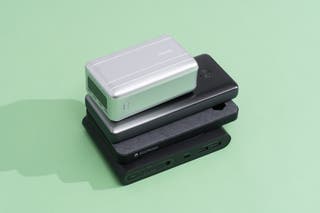
We built a list of contenders based on the following features:
- USB-C PD charging: We required every model in our test group to have at least one USB-C PD port, which enables the fastest possible charging (output) and recharging (input) speeds.
- At least a 30-watt output: We required each power bank to support an output of 30 watts or higher. Most laptops powered over USB-C need at least 30 watts to charge at top speed—that’s why Apple’s 2020 M1 and 2022 M2 MacBook Air laptops each come with a 30-watt charger. Many laptops need at least 60 watts to charge at top speed but can still charge (albeit slowly) with a 30-watt charger. Smaller devices such as an iPhone 8 or newer or a Nintendo Switch can charge safely from most USB-C ports, and need just 18 watts to charge at top speed.
- A capacity rating of 20,000 mAh to 26,800 mAh: We set a minimum rated capacity of 20,000 mAh, which is enough to charge the MacBook Air M2 or the HP EliteBook 840 G9 at least once, a Google Pixel 7 at least three times, or an iPhone 14 at least four times. We also disqualified models exceeding 26,800 mAh, which is roughly equivalent to 100 Wh, because the TSA doesn’t allow you to carry spare batteries over 100 Wh on a plane without airline approval (the FAA prohibits power banks of any capacity in checked baggage).
- A weight less than 2 pounds: Since these power banks are intended to be carried around in a backpack or a laptop bag—sometimes for long journeys—we disqualified models weighing 2 pounds and up.
- A cost of $250 or less: Since most people who use portable laptop chargers rely on them for work or travel, perhaps daily, we don’t think it’s a product you should scrimp on.
- At least a one-year warranty: We required each model to have at least a one-year warranty, which should give you ample time to bring your power bank on a few trips and ensure it works properly.
- Pass-through charging: We gave preference to models with pass-through charging, a worthwhile feature that allows you to charge one or more devices while recharging the power bank itself.
- Auxiliary charging ports: USB-A ports and wireless charging pads charge devices at a snail’s pace, but they can be handy for charging low-power devices such as wireless headphones or smartwatches. Likewise, DC ports are useful if you have a compatible laptop.
- Ability to double as a hub: Hub functionality lets you pass power and data from your laptop to other devices, such as a smartphone or digital camera, while the laptop is charging from the battery.
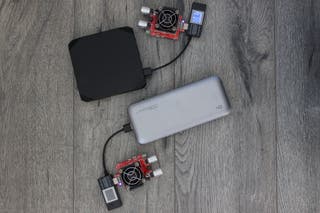
We tested the performance of each power bank in a few key areas, including:
- USB-C PD charging speed: We measured USB-C PD output by connecting a half-charged power bank to a Total Phase USB Power Delivery Analyzer, a USB-C cable, and a 13-inch MacBook Air, and recording the maximum output in watts.
- USB-A charging speed: We measured USB-A output by connecting a half-charged power bank to a PortaPow USB Power Monitor and a Drok USB Load Tester, and recording the maximum output in watts.
- USB-C PD recharging speed: We measured USB-C PD input by connecting a fully drained power bank to a Total Phase USB Power Delivery Analyzer and a laptop charger, and recording the input in watts.
- Micro-USB recharging speed: For those models offering Micro-USB input, we connected a fully drained power bank to a PortaPow, a Micro-USB cable, and a USB-C wall charger plugged into a wall outlet, and recorded the input in watts.
- Compatibility: We tested each power bank with a variety of laptops, phones, and a Nintendo Switch to confirm that they could charge some of the most popular electronics.
- Weight: We weighed each power bank using an Escali Primo Digital Scale to confirm the advertised weight.
- Look and feel: We took note of each power bank’s bulk and exterior texture, and tried fitting them into various cable organizers and laptop backpack pockets to gauge their packability. We considered how easy and intuitive their basic features—such as power buttons and charging-status lights—were to use, as well as any extra features or included accessories.
Our pick: Anker 747 PowerCore 26K
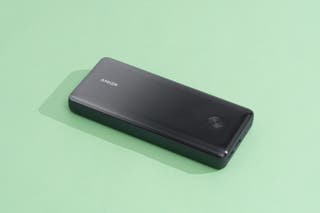
Top pick
Anker 747 PowerCore 26K
The best USB power bank for most laptops
This power bank has two USB-C PD ports, two USB-A ports, and enough capacity to charge most laptops at least once. It lacks pass-through charging, but includes a wall charger.
Buying Options
You save $59 (41%)
You save $59 (41%)
If you want a powerful, durable power bank to keep a laptop and other essential devices charged while you’re on the go, the Anker 747 PowerCore 26K is your best bet. It offers as much output power and battery capacity as any model we’ve tested, and it weighs just over a pound.
It is simple to use, ruggedly built, and one of just a few models we tested that comes with its own wall charger.
Its primary downside is that it lacks pass-through charging, so you can’t charge other devices while it’s recharging itself, but for most people its overall performance outweighs that small inconvenience.
It has great battery life. This power bank’s rated capacity (25,600 mAh, or about 92 Wh) is among the highest of those we tested, giving you enough juice to fully charge most laptops at least once.
Plus, since it falls under the TSA’s capacity limit for carry-on bags, you can safely bring it on a plane.
It has plentiful power and ports. This model has two USB-C PD ports that each support up to 87 W charging (or 63 W combined), as well as two USB-A ports that support up to 15 W charging (individually or combined), with a total peak output of 78 W.
The USB-C PD ports supply enough power to charge ultrabooks and heavy-duty laptops as fast as physically possible. The USB-A ports aren’t quite powerful enough to charge most handheld devices at top speed, but they can still charge the Nintendo Switch (in handheld mode) or recent iPhones at a relatively rapid pace.
It’s sleek, small, and light. This model has a slim, streamlined shape and weighs just 1.3 pounds.
It’s sturdily built, relatively rugged, and its rounded edges make it comfortable to hold and easy to slip into a backpack or briefcase.
Its polished aluminum finish is lustrous and sophisticated-looking, and it doesn’t attract many smudges or fingerprints.
It’s a great value, with added peace of mind. Despite coming bundled with a 65 W USB-C wall charger, a USB-C cable, and a protective cloth pouch, this model costs less than many of the models we tested.
Anker covers it with an 18-month warranty, which allows plenty of time for you to confirm that your unit is working properly.
We’ve found the company’s customer support to be reliable and responsive, too.
Flaws but not dealbreakers
- This power bank’s biggest downside is its lack of pass-through charging, which means you can’t use it to charge other devices while the unit itself is being charged. This is an inconvenience if you travel with lots of devices, but less so if you’ll primarily use your power bank to charge a single device at a time, such as a laptop or a handheld gaming console. As a workaround, you can make sure to pack a multiport wall charger so that you can recharge the unit while charging another device, such as a phone or a pair of wireless headphones, though doing this negates the benefit of the included single-port wall charger.
- Unlike some models that have a screen, you can’t check this power bank’s input and output wattages, or the precise percentage of battery remaining, at a glance. But we think most people can glean ample information from its circular formation of small LEDs, which light up to signal when power is passing in or out and (based on the number of lights that stay illuminated) give a rough estimate of how much battery life is left.
Advertisement
SKIP ADVERTISEMENT
Also great: Omnicharge Omni Mobile 25600
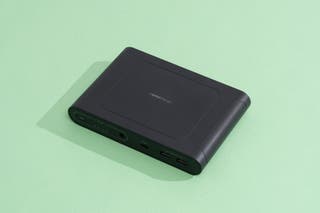
Also great
Omnicharge Omni Mobile 25600
If you want lots of charging options
With a USB-C PD port, a DC port, two USB-A ports, and a wireless charging pad, this power bank has oodles of charging options. It doesn’t come with a wall charger, but it’s compact and has enough capacity to charge most laptops at least once.
Buying Options
Use promo codePOWERBANK20
If you want the option to charge your laptop from a round DC port or to charge smaller devices wirelessly, opt for the Omnicharge Omni Mobile 25600. It’s about as lightweight and portable as our top pick, and it has a similar capacity rating. Although its output capabilities are less than stellar compared with our top pick, it lets you charge a wider variety of devices while you’re on the go, offering USB-C PD, USB-A, DC, and wireless charging.
It has a lower maximum output and input than our other picks. This model’s single USB-C PD port has a maximum output of 60 W for charging other devices, and it can take a maximum input of 45 W when recharging itself.
While neither wattage is optimal, that’s still enough power to charge a professional-grade laptop like the 13-inch MacBook Pro M1 as fast as physically possible. Likewise, both of its 18 W USB-A ports have ample power to charge a Google Pixel 7, a Nintendo Switch in handheld mode, or an iPhone 8 or newer.
It offers charging options our other picks don’t. These include a 10 W wireless charging pad with plenty of room to accommodate a phone, smartwatch, or other portable device with wireless-charging capabilities. It also has a 72 W DC input/output port to charge a laptop, digital camera, drone, or other compatible device, or to recharge the unit itself, with a compatible charging cord (not included).
Even though most people are unlikely to already have such a cable on hand, this port is a nice-to-have feature if your laptop can take advantage of it, since the higher output from DC charges slightly faster than the USB-C PD port on this unit.
It has plenty of battery capacity. This power bank’s rated capacity (25,600 mAh, or about 92 Wh) matches that of our top pick, enabling it to bring most laptop batteries from empty to full at least once.
It’s lightweight, slim, and easy to use. This power bank weighs even less than our top pick, at just 1.2 pounds.
Its slim design makes it easy to slip into a bag for commuting or longer trips, and it has a sturdy build and a sleek appearance that wouldn’t look out of place in a boardroom or a bar. It’s relatively easy to use, since all of its charging ports are on the same side, which also houses the power button and voltage indicator lights.
It offers pass-through charging from its USB-A ports. You can charge up to three small devices via the USB-A ports—or use the wireless charging pad—while the power bank itself is recharging from either the USB-C port or the DC port (neither input port has pass-through charging capabilities).
It’s on the pricier side. Costing $149 at this writing, this model costs a bit more than our top pick. Also, fewer accessories come in the box (just a C-to-C cable and an A-to-C cable), and Omnicharge’s one-year warranty is shorter than most. But if you want a wider variety of charging options, it’s still a good value.
Budget pick: Einova Eggtronic 63W Power Bank
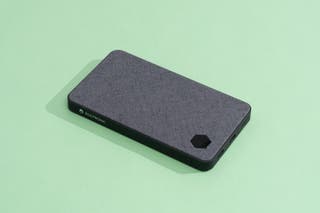
Budget pick
Einova Eggtronic 63W Power Bank
More portable, less power
This power bank has one USB-C PD port, two USB-A ports, and a sleek fabric exterior. It has less capacity and power than other options, but it’s also the lightest and cheapest model we recommend.
Buying Options
The Einova Eggtronic 63W Power Bank lacks some of the features that make our top pick great—it has less capacity, less power, fewer ports, fewer included accessories, and a shorter warranty, and it seems slightly less ruggedly built—but it’s still a solid option for the price. If you’re on a tight budget and can stomach sacrificing some performance to cut costs, this power bank is the one to get.
It can charge lower-powered devices at full speed, but will take longer with powerful laptops. The Einova model’s sole USB-C PD port can output up to 45 W, so it can charge most handheld devices, such as a Nintendo Switch or an iPad, iPad Air, or iPad Pro, at maximum speed, but it tops up most laptops at a slower pace than our other picks.
Likewise, its maximum input is just 30 W, so it’s slower than the rest of the bunch in recharging itself. It has two USB-A ports, which both support pass-through charging and got up to 15 W and 12 W respectively (or 15 W combined when the unit was plugged in) during our testing. That’s enough power to charge a phone or another small device, but not at top speed (for instance, the iPhone 8 and newer models require at least 18 W for fast-charging, and most Samsung Galaxy S22 Series phones need at least 25 W).
Its capacity is lower than our other picks, too, but still enough to recharge most laptops. Our other picks surpass this model in battery life, as it offers a rated capacity of just 20,000 mAh. It can charge most laptops (including the MacBook Air M2 or HP EliteBook 840 G9) at least once or simply top off larger models.
It has enough capacity to fully charge a phone like the Google Pixel 7 three times or more, or an iPhone 14 four times or more. And like our other picks, it meets the TSA’s battery-capacity requirements, so you can carry it on a plane.
But as a result, it’s the lightest and slimmest of our picks. At exactly a pound, it’s lighter than our top pick and has a much slimmer profile, which is nice if you prefer to carry a smaller bag. While our other picks might seem a smidgen sturdier than this model, we love the sophisticated look and soft feel of its fabric exterior.
It has a screen. This model is the only one of our picks with a screen, and while it doesn’t supply much information—just the percentage of battery life remaining—it’s still effective.
It’s remarkably inexpensive. At this writing, the Einova power bank costs $47, which is less than half the price of our other picks. It doesn’t come with a wall charger like that model does, but it includes a USB-C charging cable and an adapter that allows you to turn the USB-A port into a second USB-C port (though it’ll still charge more slowly than a true USB-C port).
It has a decent warranty. Einova’s one-year warranty is half as long as that of our top pick, but that still gives you plenty of time to take your power bank on a few trips and confirm that it works properly.
Advertisement
SKIP ADVERTISEMENT
Other power banks worth considering
If you’re willing to pay a premium for wireless charging and hub functionality, and you can overlook a lower capacity and fewer included accessories: Get the Omnicharge Omni 20c+. It pales in comparison to most of our picks in rated capacity (20,000 mAh), and it’s one of the priciest models we tested, but it’s the only option with both wireless charging and hub functionality.
In addition to its 10 W wireless charging pad, it has two USB-C PD ports (one with up to 100 W output, and the other with up to 60 W output) and two 18 W USB-A ports. All four ports have pass-through charging capabilities.
Weighing just 1.1 pounds, its compact size and shape make it easy to stow in a bag, and it has a sleek, professional look. It also has an easy-to-read screen that displays helpful information such as the internal temperature, the remaining battery life, the input and output wattage, and icons indicating which ports are in use.
It’s simple to use: A single button turns it on and off, and holding down the same button activates and deactivates the hub feature. And it comes with a USB-C charging cable, though sadly you have to supply your own wall charger (the hard-shell case that pairs with it is handy but also sold separately).
Omnicharge’s one-year warranty is on the shorter side, and this model costs $250 at this writing, but if those trade-offs are tolerable to you it’s still a great option.
If you want an exceptionally light power bank that’s relatively inexpensive, and you can overlook a lower capacity and fewer included accessories: Get the Baseus Blade. It has a rated capacity of 20,000 mAh, which is lower than most of our picks but still enough power to charge most laptops.
It has two USB-C PD ports that can output up to 100 W apiece, and two USB-A ports that can reach up to 30 W apiece. It has pass-through charging capabilities, and when all four ports are in use it has a total output of up to 30 W.
It’s intuitive to use, with a single on/off button and a brightly lit screen that shows the remaining battery life and input/output power. It’s lighter than our picks, weighing just under a pound, and has a super-slim shape.
It comes with a USB-C-to-C charging cable and cloth case, but (like most of our picks) no wall charger. Its one-year warranty is on the shorter side, but still adequate. And as of this writing, it costs just $60.
What to look forward to
We’re currently testing the following models:
- Anker A1286 Power Bank
- Anker A1289 Power Bank
- Anker A1340 Power Bank
- Anker 1383 Power Bank
- Anker Zolo Power Bank (A1689)
- Anker Zolo Power Bank (A1681)
- Belkin BoostCharge Pro 3-Port Laptop Power Bank 20K
- BioLite 100W USB-C Power Bank
- Elecom Nestout Rugged Power Bank
- Iniu BI-B63 Power Bank
- Iniu BI-B64 Power Bank
- Jackery Explorer 100 Plus Power Station
- Nitecore NB20000 Gen 3 Power Bank
- Targus 140W USB-C Portable Power Bank
- Ugreen Nexode Power Bank
Advertisement
SKIP ADVERTISEMENT
The competition
This is not a comprehensive list of all USB-C power banks we have tested. We have removed any models that have been discontinued or that no longer meet our criteria.
The Anker Prime A1336 is more than twice as powerful as our top pick (we measured up to 200 W) and it costs a bit less ($90 at this writing). It also has a longer warranty (two years), a super-compact size and shape, and an informative screen showing the remaining battery life and input/output power. However, it’s on the heavier side (1.2 pounds), has a lower capacity rating (20,000 mAh), comes with fewer accessories (just a C-to-C charging cable), and offers fewer charging options (it has two USB-C PD ports and just one USB-A port).
We also dislike the charging base that you can buy for it separately or as a bundle; the power bank sits vertically on the base, and doesn’t lock securely into place, so it’s easy to topple over. Not only does this disrupt the flow of power, but it could damage your devices.
The Baseus Blade 2 has a lower rated capacity than other models we tested for this guide (12,000 mAh, which isn’t enough to fully charge most laptops). But we still tested it since it’s slimmer (just over ¼ inch thick) and lighter (about ¾ of a pound) than our picks, and it adds an informative screen. Unfortunately, it costs more than our budget pick ($66 at this writing) despite having fewer charging ports (two USB-C PD) and less power (we measured up to 65 W input/output while using each port individually, and up to 60 W with both ports in use).
We had high hopes for the Goal Zero New Sherpa 100PD based on its great capacity and output ratings, as well as our past experience with some of the brand’s other products. However, in our hands-on testing, its somewhat clunky design and bulk (it weighs 1.5 pounds) overshadowed its performance in those key areas.
The HyperJuice 245W USB-C Battery Pack is the heaviest model we tested, as well as one of the most expensive. In our output tests, it was not as powerful as advertised, and in look and feel it’s lackluster in comparison with other contenders.
The Lenovo Go USB-C Laptop Power Bank is one of the lightest models we tested, weighing just 14.4 ounces, and it’s the only one with a built-in charging cable. However, the rubber tab used to pull the cable out of its holster feels flimsy, and if it tore or broke off completely the cable would become unusable. Plus, our picks offer more capacity and/or output for the price.
The Mophie Powerstation Pro doesn’t offer much capacity or power for the price, and its exterior isn’t especially rugged or luxurious in comparison with other fabric-covered devices we’ve tested.
The Ugreen 145W Power Bank costs less than our top pick, and it’s a few ounces lighter, but it has fewer USB-C PD ports (two), a lower capacity rating (25,000 mAh), and a less informative screen.
The ZMI PowerPack No. 20 Model QB826G costs more than our top pick, and it has fewer USB-C PD ports (two), a lower capacity rating (25,000 mAh), and a less informative screen.
This article was edited by Ben Keough and Erica Ogg.
Meet your guide

Sarah Witman
Sarah Witman is a senior staff writer who reports on powering and charging technology for Wirecutter. She previously worked as a writer, editor, and fact checker for several science magazines. Though she researches and tests chargers for a living, her phone battery is usually low.
Further reading
-

The Best Portable Laptop Charger
by Sarah Witman
When wall outlets are scarce, a portable laptop charger provides a handy backup for travelers or remote workers. Mophie’s Powerstation Pro AC is our favorite.
-

Why You Should Switch to USB-C Fast Charging Now
by Mark Smirniotis
Save time and money by switching to USB-C. Here’s what USB-C is, why you should switch, how to power your phone twice as fast, and how to make the transition.
-

The Best USB Phone Charger
by Sarah Witman and Nick Guy
No matter what kinds of USB-powered devices you own, we have picks to power them at their fastest charging speeds.
-

The Best USB-C Laptop and Tablet Chargers
by Sarah Witman
The best replacement for your original charger is the Nekteck 60W USB-C GaN Charger. It’s cheaper and smaller but just as powerful and reliable.
Advertisement
SKIP ADVERTISEMENT